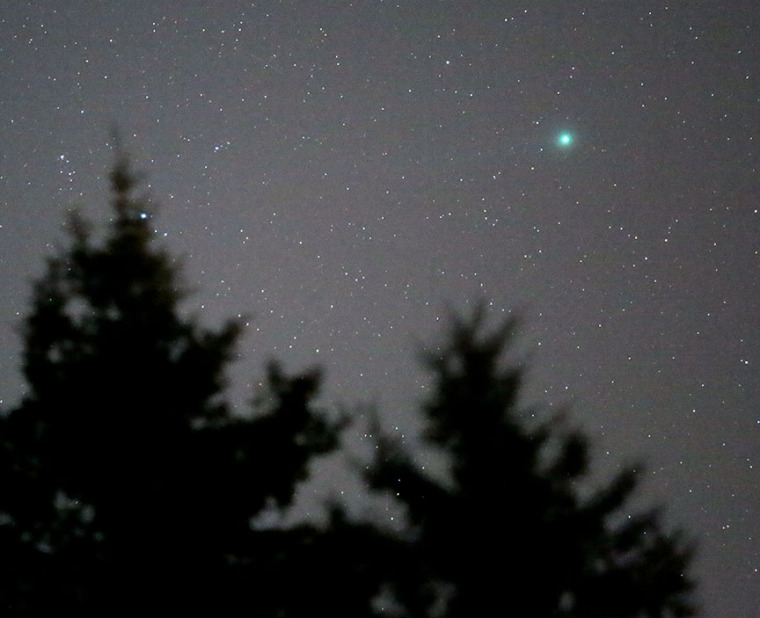Green Comet Lovejoy To Brighten Skies Until Mid-January 2015

Amateur astronomers are in for a treat even after a once-in-a-lifetime green comet made its closest approach to Earth – an event that will not happen again in 8,000 years.
Comet Lovejoy passed closest to Earth on Wednesday, Jan. 7, when it streaked some 43.6 million miles away. It will still brighten up the sky for a couple more weeks, EarthSky reported.
"Many across the globe have already seen this comet as it has brightened in recent weeks. Plus, the moon is now waning, rising an hour later each evening," the group said.
"Comets tend to brighten as they draw nearer the sun that binds them in orbit. Comet Lovejoy is no exception. Over the past months, it has been getting brighter at it heads toward its January 30 perihelion or closest point to the sun," it added.
The New Year's comet appears as a softly glowing, bluish green ball through a small telescope or binoculars and can be glimpsed as a small smudge of light on a clear dark night with the naked eye, The Telegraph said.
Comet Lovejoy is a big chunk of ice and dust orbiting the sun that belongs to the family of "long period" comets, which means it takes a long time to travel in from the fringes of the Solar System.
Experts claimed that the heavenly body passed through the inner solar system around 11,500 years ago, expecting it not to return for another 8,000 more.
"The gravity of our Solar System's planets is thought to have altered the comet's orbit a bit. Its next return is now being projected for about 8,000 years from now," EarthSky explained.
Terry Lovejoy, a comet-hunter from Birkdale in Queensland, Australia, discovered the comet just before dawn on Aug. 17, 2014 with CCD camera images using a Celestron C-8 telescope. This is his fifth comet discovery since 2007.
 Christians don't have to affirm transgenderism, but they can’t express that view at work: tribunal
Christians don't have to affirm transgenderism, but they can’t express that view at work: tribunal Archaeology discovery: Medieval Christian prayer beads found on Holy Island
Archaeology discovery: Medieval Christian prayer beads found on Holy Island Presbyterian Church in America votes to leave National Association of Evangelicals
Presbyterian Church in America votes to leave National Association of Evangelicals Over 50 killed in 'vile and satanic' attack at Nigerian church on Pentecost Sunday
Over 50 killed in 'vile and satanic' attack at Nigerian church on Pentecost Sunday Ukrainian Orthodox Church severs ties with Moscow over Patriarch Kirill's support for Putin's war
Ukrainian Orthodox Church severs ties with Moscow over Patriarch Kirill's support for Putin's war Islamic State kills 20 Nigerian Christians as revenge for US airstrike
Islamic State kills 20 Nigerian Christians as revenge for US airstrike Man who served 33 years in prison for murder leads inmates to Christ
Man who served 33 years in prison for murder leads inmates to Christ


 Nigerian student beaten to death, body burned over ‘blasphemous’ WhatsApp message
Nigerian student beaten to death, body burned over ‘blasphemous’ WhatsApp message 'A new low': World reacts after Hong Kong arrests 90-year-old Cardinal Joseph Zen
'A new low': World reacts after Hong Kong arrests 90-year-old Cardinal Joseph Zen Iran sentences Christian man to 10 years in prison for hosting house church worship gathering
Iran sentences Christian man to 10 years in prison for hosting house church worship gathering French Guyana: Pastor shot dead, church set on fire after meeting delegation of Evangelicals
French Guyana: Pastor shot dead, church set on fire after meeting delegation of Evangelicals ‘Talking Jesus’ report finds only 6% of UK adults identify as practicing Christians
‘Talking Jesus’ report finds only 6% of UK adults identify as practicing Christians Mission Eurasia ministry center blown up in Ukraine, hundreds of Bibles destroyed: 'God will provide'
Mission Eurasia ministry center blown up in Ukraine, hundreds of Bibles destroyed: 'God will provide' Church holds service for first time after ISIS desecrated it 8 years ago
Church holds service for first time after ISIS desecrated it 8 years ago Burger King apologizes for 'offensive campaign' using Jesus' words at the Last Supper
Burger King apologizes for 'offensive campaign' using Jesus' words at the Last Supper Uganda: Muslims abduct teacher, burn him inside mosque for praying in Christ’s name
Uganda: Muslims abduct teacher, burn him inside mosque for praying in Christ’s name